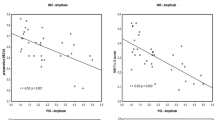Abstract
• Background: Prognostically favorable factors for epiretinal membrane removal have been described in the literature by several authors. Little information, however, is available about the objective assessment of the preoperative macular function. This study reports the results of idiopathic epiretinal membrane removal and the prognostic value of preoperative pattern reversal visual-evoked potentials (PRVEPS) in recovery of visual acuity (VA). • Methods: In 60 patients (60 eyes) with idiopathic epiretinal membrane we performed PRVEP examination preoperatively. All eyes were operated on by standard three-port vitrectomy with membrane removal. Two eyes were excluded because of postoperative complications. Follow-up VA was compared with preoperative VA for the 58 study eyes and correlated with preoperative PRVEP parameters. • Results: The mean preoperative VA was 0.2, the mean postoperative VA, 0.4. The PRVEP was recordable in 74%, 67% and 36% of cases for check sizes of 17, 10 and 7 arcmin respectively. Twenty patients (50%) had an increase in VA of two lines or more, in 25 patients (43%) VA remained within one line of the preoperative value, and in 4 patients (7%) VA decreased by two lines or more. The mean preoperative VA was not significantly different between the group with an improved VA and the group that did not benefit from membrane removal. Of the PRVEP parameters, only the N80 latency for the 17' check size was significantly associated with postoperative visual outcome. • Conclusion: The PRVEP is applicable as a predictor for visual outcome in cases of epiretinal membrane removal. For the 17' pattern size we found a significant association of the combination of recordability and delayed N80 latency with visual outcome.
Similar content being viewed by others
References
Arden GB, Carter RM, MacFarlan A (1984) Pattern and Ganzfeld electroretinogram in macular disease. Br J Ophthalmol 68:878–884
Bartel P, Becker P, Robinson E (1991) The intrasession repeatability of pattern electroretinograms and the effects of digital filtering. Doc Ophthalmol 76:351–358
Bass SJ, Sherman J, Bodis-Wollner I, Nath S (1985) Visual evoked potentials in macular disease. Invest Ophthalmol Vis Sci 26:1071–1074
Bemelmans NAM, Cuypers MHM, Pinckers AJLG, Hommes OR (1995) Pattern reversal visual evoked potentials: influence of age, gender and check size in the diagnosis of multiple sclerosis. Neuroophthalmology 15:83–91
Bemelmans NAM, Tilanus MAD, Cuypers MHM, Pinckers AJLG (1997) Pattern-reversal visual evoked potentials in patients with epiretinal membrane. Am J Ophthalmol 123:97–102
Berninger T, Arden GB (1991) The pattern electroretinogram. In: Heckenlively JR, Arden GB (eds) Principles and practice of clinical electrophysiology of vision. Mosby-Year Book, St. Louis, pp 291–300
Birch DG, Anderson JL, Fish GE, Jost BF (1992) Pattern-reversal electroretinographic acuity in untreated eyes with subfoveal neovascular membranes. Invest Ophthalmol Vis Sci 33:2097–2104
Callaway E, Haliday RA (1973) Evoked potential variability: effects of age, amplitude and methods of measurement. Electroencephalogr Clin Neurophysiol 34:125–133
Celesia GG, Kaufman D (1985) Pattern ERG's and visual evoked potentials in maculopathies and optic nerve diseases. Invest Ophthalmol Vis Sci 26:726–735
Ciganek L (1961) The EEG response: evoked potential to light stimulus in man. Invest Ophthalmol Vis Sci 26:1071–1074
Cuypers MHM, Dickson K, Pinckers AJLG, Thijssen JM, Hommes OR (1995) Discriminative power of visual evoked potential characteristics in multiple sclerosis. Doc Ophthalmol 90:247–257
Davidson DW (1991) Visual acuity. In: Eskridge JB, Amos JF, Bartlett JD (eds) Clinical procedures in optometry. Lippincott, Philadelphia, pp 17–29
DeBustros S, Rice TA, Michels RG, Thompson JT, Marcus S, Glaser BM (1988) Vitrectomy for macular pucker. Arch Ophthalmol 106:758–760
Holopigian K, Snow J, Seiple W, Siegel I (1988) Variability of the pattern electroretinogram. Doc Ophthalmol 70:102–115
Hull BM, Thompson DA (1989) A review of the clinical applications of the pattern electroretinogram. Ophthalmic Physiol Opt 9:143–152
Kakisu Y, Mizota A, Adachi E (1986) Clinical application of pattern electroretinogram with lid skin electrode. Doc Ophthalmol 63:187–194
Katsumi O, Tetsuka H, Hoon-Ohn Y, Hirose T (1993) Effects of light scatter, defocusing, contrast, and central scotoma on the PVER amplitude-check size function curve. Acta Ophthalmol 71:606–615
Kurita-Tashima S, Tobimatsu S, Nakayama-Hiromatsu M, Kato M (1991) Effect of check size on the pattern reversal visual evoked potential. Electroencephalogr Clin Neurophysiol 80:161–166
Mehta MC, Katsumi O, Buzney SM, Hirose T (1992) Pattern evoked response as a prognostic indicator in macular membrane. Am J Ophthalmol 113:39–44
Michels RG (1981) Vitreous surgery for macular pucker. Am J Ophthalmol 92:628–639
Morgan CM, Schatz H (1985) Idiopathic macular holes. Am J Ophthalmol 99:437–444
Odom JV, Maida TM, Dawson WW, Hobson R (1987) Pattern electroretinogram: effects of reference electrode position. Doc Ophthalmol 65:297–306
Pesin SR, Olk RJ, Grand MG, Boniuk I, Arribas NP, Thomas MA, Williams DF, Burgess D (1991) Vitrectomy for premacular fibroplasia. Am J Ophthalmol 98:1109–1114
Rice TA, DeBustros S, Michels RG, Thompson JT, Debanne SM, Rowland DY (1986) Prognostic factors in vitrectomy for epiretinal membranes of the macula. Ophthalmology 93:602–610
Sokol S (1972) An electrodiagnostic index of macular function. Arch Ophthalmol 88:619–624
Török B, Meyer M, Wildberger H (1992) The influence of pattern size on amplitude, latency and wave form of retinal and cortical potentials elicited by checkerboard pattern reversal and stimulus onset-offset. Electroencephalogr Clin Neurophys 84:13–19
Trese M, Chandler DB, Machemer R (1983) Macular pucker. Graefe's Arch Clin Exp Ophthalmol 221:16–26
Von Gunten S, Pournaras CJ, de Grottau P, Brazitikos P (1994) Facteurs prognostiques du traitement chirurgical du membranes epiretiniennes. Klin Monatsbl Augenheilkd 204:309–312
Author information
Authors and Affiliations
Rights and permissions
About this article
Cite this article
Tilanus, M.A.D., Cuypers, M.H., Bemelmans, N.A.M. et al. Prognostic value of pattern reversal visual-evoked potentials in idiopathic epiretinal membrane. Graefe's Arch Clin Exp Ophthalmol 235, 474–479 (1997). https://doi.org/10.1007/BF00947002
Received:
Revised:
Accepted:
Issue Date:
DOI: https://doi.org/10.1007/BF00947002




